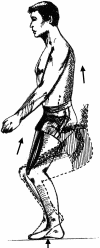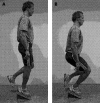The evolution of eccentric training as treatment for patellar tendinopathy (jumper's knee): a critical review of exercise programmes
- PMID: 17261559
- PMCID: PMC2658948
- DOI: 10.1136/bjsm.2006.032417
The evolution of eccentric training as treatment for patellar tendinopathy (jumper's knee): a critical review of exercise programmes
Abstract
Background and aim: Eccentric training has become a popular treatment for patellar tendinopathy. Our purpose was to review the evolution of eccentric strength training programmes for patellar tendinopathy with a focus on the exercise prescriptions used, to help clinicians make appropriate choices and identify areas needing further research.
Methods: A computerised search of the entire MEDLINE database was performed on 1 September 2006 to identify prospective and randomised clinical trials with a focus on clinical outcome of eccentric training for patellar tendinopathy.
Results: 7 articles with a total of 162 patients and in which eccentric training was one of the interventions, all published after 2000, were included. The results were positive, but study quality was variable, with small numbers or short follow-up periods. The content of the different training programmes varied, but most were home-based programmes with twice daily training for 12 weeks. A number of potentially significant differences were identified in the eccentric programmes used: drop squats or slow eccentric movement, squatting on a decline board or level ground, exercising into tendon pain or short of pain, loading the eccentric phase only or both phases, and progressing with speed then loading or simply loading.
Conclusion: Most studies suggest that eccentric training may have a positive effect, but our ability to recommend a specific protocol is limited. The studies available indicate that the treatment programme should include a decline board and should be performed with some level of discomfort, and that athletes should be removed from sports activity. However, these aspects need further study.
Conflict of interest statement
Competing interests: None declared.
References
-
- Ferretti A. Epidemiology of jumper's knee. Sports Med 19863289–295. - PubMed
-
- Lian O B, Engebretsen L, Bahr R. Prevalence of jumper's knee among elite athletes from different sports: a cross‐sectional study. Am J Sports Med 200533561–567. - PubMed
-
- Alfredson H. The chronic painful Achilles and patellar tendon: research on basic biology and treatment. Scand J Med Sci Sports 200515252–259. - PubMed
Publication types
MeSH terms
LinkOut - more resources
Full Text Sources
Medical



